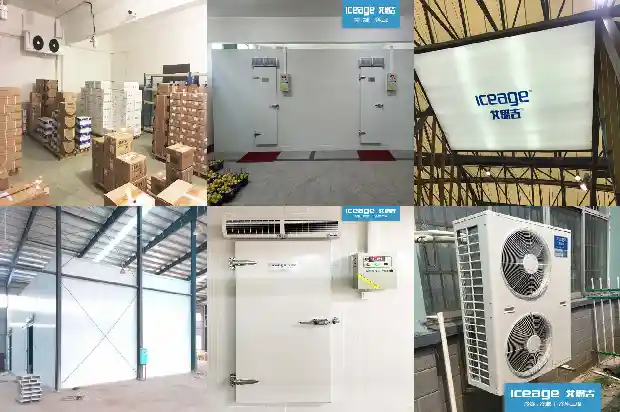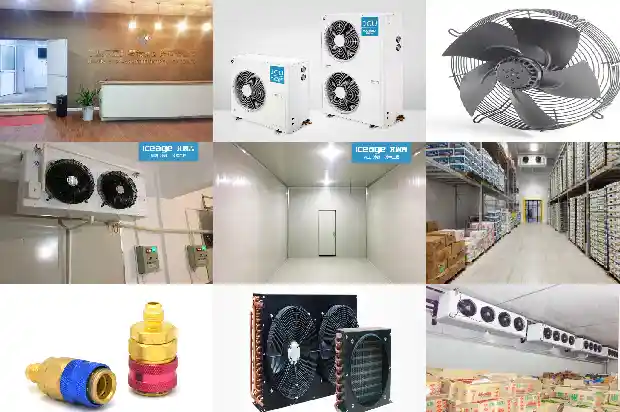Don't Panic When the Refrigeration System Is Blocked: Here Are the Retrieval and Cleaning Methods
2025-04-16
Typical Characteristics of Blockage
- The refrigerator or air conditioner runs for a long time without cooling.
- The suction pressure drops, and even a vacuum state (negative pressure) occurs.

- The load of the compressor decreases, the operating current of the motor decreases, and the vibration and noise of the compressor weaken.
- When you put your ear close to the outer wall of the refrigerator or air conditioner, you can't hear the flow sound of the refrigerant.
- Severe frosting occurs behind the expansion valve.
If there is a blockage in the system or the refrigerant does not flow smoothly, and the refrigerant circulation volume decreases, the fault characteristics are the same as those above, but the severity is relatively mild.
Classification of Blockage - "Dirt Blockage"
There are dirt substances in the refrigeration system, such as copper chips, welding slag, dust, etc., which cause blockage. - "Ice Blockage"
Water vapor in the refrigeration system, when passing through the throttling device, the temperature drops rapidly below the freezing point, resulting in ice formation, thus blocking the capillary tube or the throttling mechanism.
Blockage of the Drying Filter
The blockage of the drying filter is often not a complete blockage. In addition to having the characteristics of "dirt blockage", its characteristic is that the capillary tube shows condensation or frosting. This is because the filter plays the role of current blocking, and the capillary tube is equivalent to an evaporator - absorbing heat and condensing. Just replace the filter.
I. Inspection and Removal of "Dirt Blockage"
The capillary tube, drying filter, and other pipelines in the refrigeration system of a refrigerator or air conditioner are blocked due to dirt, which is called "dirt blockage". - Causes of "Dirt Blockage": Residual dirt in the system during manufacturing, the shedding of metal oxides in the system pipeline, sealing dirt into the system during the repair process, and the molecular sieve or silica gel powder in the filter entering the capillary tube, etc.
- Removal Method of "Dirt Blockage": It mostly occurs in the capillary tube and the filter. Replace the filter if it is blocked. When it is inconvenient to replace the blocked capillary tube, nitrogen with a pressure of about 1MPa can be used for blowing. The nitrogen enters from the return air pipe (evaporator) end and is released from the condenser (or directly discharged from the capillary tube). Press the air release port of the condenser with your hand and then quickly release it to increase the impact on the capillary tube. The "dirt blockage" of the capillary tube mostly occurs at the inlet end. Replacing the exposed part of the capillary tube is effective in most cases. (Tip: In any case, the filter should be replaced while cleaning the capillary tube!)
II. Inspection and Removal of "Ice Blockage"
Due to the presence of water vapor in the refrigeration system, when the evaporation temperature of the refrigerant is lower than 0°C, the water vapor is trapped at the outlet of the capillary tube and forms ice beads, blocking the capillary tube, which is called "ice blockage".
Typical Characteristics of "Ice Blockage": After the "ice blockage" fault occurs, the characteristics of the refrigerator are the same as those when there is a complete "dirt blockage" (the characteristic of the air conditioner is that part of the evaporator does not cool). The difference between the two is that "dirt blockage" is permanent and will not disappear on its own. However, "ice blockage" changes with temperature and only occurs when the refrigerant is lower than 0°C. When the ice beads melt, the "ice blockage" disappears on its own.
III. Sources of Moisture in the Refrigeration System - There are leakage holes in the low-pressure part of the refrigeration system, the refrigerant leaks seriously, and after the compressor runs, the low-pressure part has a negative pressure, sucking in a large amount of air, thus bringing in water vapor.
- After the refrigeration system is opened and communicates with the atmosphere, if it is stored for too long, the refrigerant will absorb the moisture in the air.
- When replacing large components such as the compressor and evaporator, the moisture in the components is not completely removed and is sealed into the system.
- The tools such as the gauge valve, hose, and gas cylinder used for charging the refrigerant into the system contain moisture. The water content of the refrigerant exceeds the standard, etc.
- When evacuating the system, the vacuum degree is not high enough, and there is still a large amount of air and moisture in the system.
IV. Removal Method of "Ice Blockage"
Eliminating the "ice blockage" fault essentially means finding a way to discharge the water vapor from the system. After the "ice blockage" occurs, the dryer has failed and should be replaced. - Exhaust and Baking: The mechanical vacuum pump has a very weak ability to remove water vapor, and it is difficult to completely remove the water vapor even after pumping for a long time. Therefore, while evacuating the system, comprehensively baking and heating up the refrigeration system is the most effective and scientific method to remove moisture. There are various baking methods, such as using a hair dryer or an electric iron to heat the evaporator, and using a blowtorch flame to heat the condenser and filter, etc.
- After the System is Evacuated: Charge the system with nitrogen at a certain pressure, then start the compressor and let it run for a while, and then release the nitrogen. Repeating this two or three times can basically eliminate the "ice blockage".
Cleaning of the Refrigeration System
The circulation of the refrigerant in the refrigeration system should be kept free of impurities, moisture, and air. After the compressor burns out, the acidity of the refrigeration oil inside the system will increase, and you can smell the tar odor when cutting open the system connection pipe. If the old refrigeration oil is not cleaned, it will corrode the coil of the new compressor used after replacement. The new compressor will burn out again soon after it is used. Therefore, the refrigeration system needs to be disassembled, and each component should be cleaned one by one.
I. Cleaning of Pipelines - Copper Pipe: First, blow it with compressor air at a flow rate of 10-15 meters per second, then corrode it with a 15%-20% hydrofluoric acid solution for 3 hours, then rinse it successively with a 10%-15% sodium carbonate solution and hot water, and finally dry it at a temperature of 120-150°C for 3-4 hours. In order to remove the water vapor, it must also be blown dry with nitrogen or dry air.
- Steel Pipe: First, inject a 5% sulfuric acid solution into the pipe and keep it for 1.5-2 hours, then inject a 10% anhydrous sodium carbonate solution for neutralization, then rinse it thoroughly with clean water and blow it dry with nitrogen or dry air, and finally purify it with a 20% sodium nitrite solution.
- Capillary Tube: First, remove the oil stain inside the tube with a high temperature of about 650°C. After cooling, blow it clean with compressed air, then rinse it with carbon tetrachloride, and finally blow it dry with nitrogen or dry air.
II. Cleaning of the Condenser and Evaporator
The above methods can also be used to clean the heat exchange devices such as the condenser and evaporator of air conditioners and small refrigeration equipment. However, for aluminum evaporators and composite steel pipes, the pickling process cannot be used. Only trichloroethylene can be used for rinsing, and then it should be blown dry with nitrogen or dry air.
Cleaning of the Outer Surface of the Air-cooled Condenser
The outer surface of the air-cooled condenser is likely to adhere to dust and oil stains, which will obstruct the air circulation, cause poor ventilation, and affect the refrigeration effect of the air conditioner.
Brushing Method: When brushing, use 70°C warm water, add a little detergent, and rinse the surface of the condenser with a special cleaning machine. If there are oil stains on the condenser, it is best to let the water with detergent stay on the condenser for a period of time. Let the detergent slowly remove the oil stains on the condenser, and finally rinse the detergent off with clean water. If the oil stains are too thick, special tools are needed for cleaning.
Related Articles
- Accessories of the Refrigeration System—Gas-Liquid Separator
- Calculation Method of the Refrigeration Capacity of Precision Air Conditioners
- Air Conditioner - Horsepower vs Air Conditioner - Refrigeration Capacity
- Do You Know the Ten Common Fault Causes of the Refrigeration System?
- Expert Decryption: Analysis of the Causes of High Superheat and Low Suction Pressure in the Refrigeration System!
- Brief Introduction to the Working Principle of Lithium Bromide Absorption Refrigeration Unit
- What Knowledge Points Should Users Know about the Safety Valve in the Refrigeration System?
- Do You Really Understand Automotive Air Conditioning Refrigerant and Refrigeration Oil?
- Can Cooling Towers Solve the Problem of Refrigeration Units Releasing Heat in Winter?
- Don't Worry When the Refrigeration Unit Malfunctions. Look Here!
- Marine Refrigeration Unit
- Do You Know These Basic Refrigeration Knowledge?
- Top Ten Common Faults of the Refrigeration System: Analysis and Solutions Included!
- Commissioning of the Refrigeration System after Installation and Major Overhaul: Very Detailed!
- Selection Methods for Site, Capacity, Insulation Materials and Refrigeration System in Cold Storage Construction Design
- Classification, Applications, Identification of Common Refrigerants and Impact of Purity on Refrigeration Systems
- The Basic Refrigeration Working Principle of Cold Storage
- What Causes the Evaporation Temperature in a Cold Storage Refrigeration System to Be Too Low?
